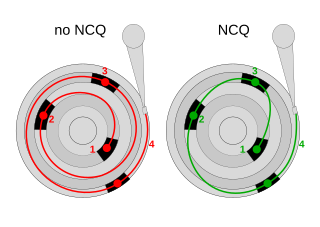In computing, scheduling is the action of assigning resources to perform tasks. The resources may be processors, network links or expansion cards. The tasks may be threads, processes or data flows.

Round-robin (RR) is one of the algorithms employed by process and network schedulers in computing. As the term is generally used, time slices are assigned to each process in equal portions and in circular order, handling all processes without priority. Round-robin scheduling is simple, easy to implement, and starvation-free. Round-robin scheduling can be applied to other scheduling problems, such as data packet scheduling in computer networks. It is an operating system concept.
Completely Fair Queuing (CFQ) is an I/O scheduler for the Linux kernel which was written in 2003 by Jens Axboe.

In computing, Native Command Queuing (NCQ) is an extension of the Serial ATA protocol allowing hard disk drives to internally optimize the order in which received read and write commands are executed. This can reduce the amount of unnecessary drive head movement, resulting in increased performance for workloads where multiple simultaneous read/write requests are outstanding, most often occurring in server-type applications.
The elevator algorithm is a disk-scheduling algorithm to determine the motion of the disk's arm and head in servicing read and write requests.
In computer science, a multilevel feedback queue is a scheduling algorithm. Scheduling algorithms are designed to have some process running at all times to keep the central processing unit (CPU) busy. The multilevel feedback queue extends standard algorithms with the following design requirements:
- Separate processes into multiple ready queues based on their need for the processor.
- Give preference to processes with short CPU bursts.
- Give preference to processes with high I/O bursts.

Shortest job next (SJN), also known as shortest job first (SJF) or shortest process next (SPN), is a scheduling policy that selects for execution the waiting process with the smallest execution time. SJN is a non-preemptive algorithm. Shortest remaining time is a preemptive variant of SJN.
sync is a standard system call in the Unix operating system, which commits all data in the kernel filesystem to non-volatile storage buffers, i.e., data which has been scheduled for writing via low-level I/O system calls. Higher-level I/O layers such as stdio may maintain separate buffers of their own.
Anticipatory scheduling is an algorithm for scheduling hard disk input/output. It seeks to increase the efficiency of disk utilization by "anticipating" future synchronous read operations.
FSCAN is a disk scheduling algorithm to determine the motion of the disk's arm and head in servicing read and write requests. It uses two sub-queues. During the scan, all of the requests are in the first queue and all new requests are put into the second queue. Thus, service of new requests is deferred until all of the old requests have been processed. When the scan ends, the arm is taken to the first queue entries and is started all over again.

The Completely Fair Scheduler (CFS) is a process scheduler that was merged into the 2.6.23 release of the Linux kernel and is the default scheduler of the tasks of the SCHED_NORMAL class. It handles CPU resource allocation for executing processes, and aims to maximize overall CPU utilization while also maximizing interactive performance.

The NOOP scheduler is the simplest I/O scheduler for the Linux kernel. This scheduler was developed by Jens Axboe.
The deadline scheduler is an I/O scheduler for the Linux kernel which was written in 2002 by Jens Axboe.
LOOK is a disk scheduling algorithm used to determine the order in which new disk read and write requests are processed.
A journaling file system is a file system that keeps track of changes not yet committed to the file system's main part by recording the goal of such changes in a data structure known as a "journal", which is usually a circular log. In the event of a system crash or power failure, such file systems can be brought back online more quickly with a lower likelihood of becoming corrupted.

The Brain Fuck Scheduler (BFS) is a process scheduler designed for the Linux kernel in August 2009 as an alternative to the Completely Fair Scheduler (CFS) and the O(1) scheduler. BFS was created by an experienced kernel programmer Con Kolivas.
zram, formerly called compcache, is a Linux kernel module for creating a compressed block device in RAM, i.e. a RAM disk with on-the-fly disk compression. The block device created with zram can then be used for swap or as general-purpose RAM disk. The two most common uses for zram are for the storage of temporary files and as a swap device. Initially, zram had only the latter function, hence the original name "compcache".
bcache is a cache in the Linux kernel's block layer, which is used for accessing secondary storage devices. It allows one or more fast storage devices, such as flash-based solid-state drives (SSDs), to act as a cache for one or more slower storage devices, such as hard disk drives (HDDs); this effectively creates hybrid volumes and provides performance improvements.
dm-cache is a component of the Linux kernel's device mapper, which is a framework for mapping block devices onto higher-level virtual block devices. It allows one or more fast storage devices, such as flash-based solid-state drives (SSDs), to act as a cache for one or more slower storage devices such as hard disk drives (HDDs); this effectively creates hybrid volumes and provides secondary storage performance improvements.
io_uring is a Linux kernel system call interface for storage device asynchronous I/O operations addressing performance issues with similar interfaces provided by functions like read /write or aio_read /aio_write etc. for operations on data accessed by file descriptors.




